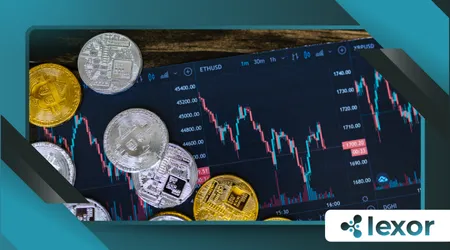Crypto for Beginners: A Simple Guide to Understanding Blockchain

For those diving into crypto for beginners, understanding blockchain—the backbone of cryptocurrencies—is the first step toward demystifying this revolutionary technology.
Whether you’re curious about Bitcoin, Ethereum, or the broader crypto ecosystem, this guide will break down blockchain in a way that’s easy to grasp, while offering actionable insights for newcomers.
As you explore this new landscape, remember that education is key.
Staying informed about market trends and technological advancements will empower you to make better decisions in your crypto journey.
What Is Blockchain? The Foundation of Crypto
At its core, a blockchain is a decentralized digital ledger that records transactions across a network of computers.
Unlike traditional banks, where a central authority oversees transactions, blockchain operates on a peer-to-peer system.
This means no single entity has control, making it transparent, secure, and resistant to fraud.
For crypto for beginners, think of blockchain as a chain of digital “blocks.”
Each block contains a list of transactions, and once a block is completed, it’s linked to the previous one, forming a chain.
This structure ensures that altering any single block would require changing every subsequent block, which is nearly impossible due to the computational power needed.
To dive deeper into blockchain technology, you can visit Investopedia’s Blockchain Explained.
Understanding this foundational concept will help you grasp the complexities of cryptocurrencies more effectively.
Why Blockchain Matters in Crypto
Blockchain isn’t just a buzzword; it’s the technology that makes cryptocurrencies possible.
Without it, Bitcoin, Ethereum, and thousands of other digital assets wouldn’t exist.
Here’s why blockchain is a game-changer:
- Decentralization: No single entity controls the network, reducing the risk of manipulation.
- Transparency: All transactions are publicly recorded and can be verified by anyone.
- Security: Cryptographic techniques ensure that data is tamper-proof.
For beginners, understanding these pillars is crucial to grasping why blockchain is so transformative.
Additionally, blockchain technology fosters trust among users, as all participants can independently verify transactions.
This transparency not only enhances security but also helps build a more inclusive financial ecosystem.
For more insights on the implications of blockchain, check out CoinDesk’s Blockchain 101.
How Blockchain Works: A Step-by-Step Breakdown
Let’s simplify how blockchain functions, step by step:
- Transaction Initiation: Someone requests a transaction (e.g., sending Bitcoin to another wallet).
- Verification: The transaction is broadcast to a network of computers (nodes) for validation.
- Block Creation: Verified transactions are grouped into a block.
- Consensus Mechanism: Nodes agree on the block’s validity using methods like Proof of Work (PoW) or Proof of Stake (PoS).
- Adding to the Chain: The block is added to the existing blockchain, and the transaction is complete.
This process ensures that every transaction is secure, transparent, and irreversible.
Moreover, these mechanisms help maintain the integrity of the blockchain, preventing double-spending and fraud.
As the technology evolves, newer consensus mechanisms are being developed to enhance efficiency and reduce energy consumption.
+ The Rise of Stablecoins: What Makes Them Different?
Table 1: Blockchain vs. Traditional Banking
| Feature | Blockchain | Traditional Banking |
|---|---|---|
| Control | Decentralized | Centralized |
| Transparency | Public ledger | Private records |
| Transaction Speed | Varies (minutes to hours) | Instant to days |
| Security | High (cryptography) | Moderate (fraud risk) |
| Accessibility | Global, 24/7 | Limited by business hours |
The Role of Cryptography in Blockchain
Cryptography is the science of securing information, and it’s the backbone of blockchain technology.
Every transaction on a blockchain is encrypted, ensuring that only the intended recipient can access the funds.
For crypto for beginners, this means your digital assets are protected by advanced mathematical algorithms that are virtually unbreakable.
Two key cryptographic concepts to know:
- Public Key: Like an email address, it’s shared openly to receive funds.
- Private Key: Like a password, it’s kept secret and used to access your crypto.
Losing your private key means losing access to your funds forever—so keep it safe!
Additionally, cryptography also plays a crucial role in maintaining user anonymity, allowing individuals to engage in transactions without revealing their identities.
This aspect is particularly important in a world where privacy concerns are increasingly relevant.
Common Misconceptions About Blockchain
As a beginner, you might encounter myths about blockchain and crypto.
Let’s debunk a few:
- Blockchain Is Only for Crypto: While it powers cryptocurrencies, blockchain has applications in supply chain management, healthcare, voting systems, and more.
- Blockchain Is Completely Anonymous: Transactions are pseudonymous, meaning they’re linked to wallet addresses, not personal identities.
- Blockchain Is Unhackable: While highly secure, no system is entirely immune to attacks.
Understanding these nuances will help you navigate the crypto space with confidence.
Moreover, being aware of these misconceptions can prevent you from falling for scams or misinformation prevalent in the crypto community.
Educating yourself through reliable sources will arm you with the knowledge needed to make informed decisions.

The Evolution of Blockchain: From Bitcoin to Web3
Blockchain technology has come a long way since Bitcoin’s inception in 2009.
Today, it’s the foundation of Web3—a new internet era focused on decentralization, user ownership, and transparency.
For crypto for beginners, it’s worth noting how blockchain has evolved:
- Bitcoin (2009): Introduced blockchain as a peer-to-peer electronic cash system.
- Ethereum (2015): Expanded blockchain’s capabilities with smart contracts.
- Web3 (Present): Envisions a decentralized internet powered by blockchain.
This progression highlights blockchain’s potential to reshape industries beyond finance.
As new projects and platforms emerge, the landscape is continually evolving, offering exciting opportunities for innovation.
Keeping an eye on these developments will help you stay ahead in the rapidly changing world of blockchain technology.
Table 2: Blockchain Generations
| Generation | Key Feature | Example |
|---|---|---|
| 1.0 | Digital Currency | Bitcoin |
| 2.0 | Smart Contracts | Ethereum |
| 3.0 | Decentralized Applications (dApps) | Polkadot, Solana |
Why Blockchain Adoption Is Growing
Blockchain adoption is skyrocketing, with the global market projected to reach $1.4 trillion by 2030, according to Grand View Research.
This growth is driven by:
- Institutional Interest: Companies like Tesla and PayPal are integrating crypto.
- Government Initiatives: Countries like El Salvador have adopted Bitcoin as legal tender.
- Technological Advancements: Innovations like Layer 2 solutions are improving scalability.
For beginners, this trend underscores the importance of understanding blockchain early.
As more industries recognize the benefits of blockchain, the demand for skilled professionals in this field is also increasing.
This presents a unique opportunity for those looking to build a career in technology or finance.
How to Get Started with Crypto
Ready to dive into the world of crypto? Here’s a quick guide for beginners:
- Educate Yourself: Learn the basics of blockchain and cryptocurrencies.
- Choose a Wallet: Select a secure wallet to store your crypto.
- Start Small: Invest only what you can afford to lose.
- Stay Updated: Follow reputable sources to stay informed about market trends.
Remember, the crypto market is volatile, so patience and research are key.
Joining online communities and forums can also provide valuable insights and support as you navigate this new landscape.
Engaging with others who share your interests can enhance your learning experience and keep you motivated.
++ Green Crypto Mining: Sustainable Blockchain Solutions
The Future of Blockchain and Crypto
As blockchain technology matures, its impact will extend far beyond cryptocurrencies.
From decentralized finance (DeFi) to non-fungible tokens (NFTs), the possibilities are endless.
For crypto for beginners, this is an exciting time to explore a technology that’s reshaping the world.
As we move forward, the integration of blockchain into various sectors will continue to evolve, leading to innovative solutions and applications.
Staying informed about these trends will help you leverage the potential of blockchain in your personal and professional life.
Final Thoughts
Blockchain is more than just the technology behind Bitcoin—it’s a paradigm shift in how we think about trust, security, and decentralization.
For those starting their journey into crypto for beginners, understanding blockchain is the first step toward unlocking the potential of this transformative technology.
So, whether you’re investing, building, or simply curious, remember: the future of finance is decentralized, and it all starts with blockchain.
As you embark on this journey, keep an open mind and be ready to adapt to the ever-changing landscape of the crypto world.
Embracing continuous learning will empower you to make informed decisions and thrive in this exciting new era.
